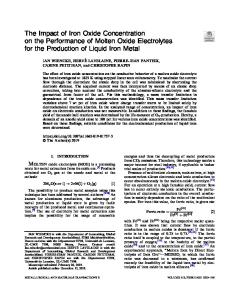The Effect of Sulfur Concentration in Liquid Iron on Mineral Layer Formation During Coke Dissolution
- PDF / 828,134 Bytes
- 10 Pages / 593.972 x 792 pts Page_size
- 117 Downloads / 385 Views
COKE is a key reagent in blast furnace iron production. It is the primary reductant of the ore, the fuel for the furnace smelting, used to control the gas permeability required for high blast furnace iron production rates, and the source of carbon in the liquid iron.[1] This investigation is focused on the coke–iron reactions occurring in the blast furnace hearth below the slag layer where coke is immersed in liquid iron. Liquid iron entering this region contains more than 2 mass pct carbon and picks up its final carbon while percolating though the coke-packed bed in the deadman and hearth regions of the blast furnace.[1] Metallurgical coke typically contains 8 to 12 mass pct of inorganic mineral matter.[2] As coke dissolves into the liquid iron, the insoluble components of this inorganic mineral matter can potentially form a layer at the coke– iron interface, inhibiting carbon dissolution.[3–14] Recent studies by the current authors[4,5,7] have demonstrated a link between coke dissolution kinetics and the morphology of the mineral layer formed at the interface. Phase MICHAEL W. CHAPMAN, Ironmaking Production Engineer, formally with the PYROmetallurgical Research Group, University of Wollongong, Wollongong, NSW 2522, Australia, is now with BlueScope Steel Limited, Port Kembla, NSW 2505, Australia. BRIAN J. MONAGHAN and SHARON A. NIGHTINGALE, Associate Professors, are with the PYROmetallurgical Research Group, University of Wollongong. Contact e-mail: [email protected] JOHN G. MATHIESON, Senior Research Manager, and ROBERT J. NIGHTINGALE, Senior Ironmaking Production Engineer, are with BlueScope Steel Limited. Manuscript submitted July 13, 2010. Article published online April 20, 2011. 642—VOLUME 42B, AUGUST 2011
morphology is partly a function of composition and it is therefore expected that morphology effects of the mineral layer at the interface will be a function of the coke mineral composition. Details of sulfide formation in the mineral layer were not discussed in the previous articles but are elaborated on as the main subject of this study. A. Previous Work Few data exist on the form, composition, and morphology of the layer that forms during coke dissolution in liquid iron. Recent studies by the current authors[4,5,7] have related measurements and observations of the composition and morphology of the mineral layer formed at the coke–liquid iron interface to the rate of coke dissolution. The mineral layer formed was primarily a calcium aluminate that progressively became enriched in calcium as the dissolution reaction proceeded. The calcium enrichment led to a change in morphology of the mineral layer that in turn slowed the rate of coke dissolution[4] in a step change. Information on what type of layer forms on the coke as the dissolution reaction proceeds comes from an excellent study by Gudenau et al.,[8] who present data on the ash (mineral matter) found on the surface of coke particles dipped in liquid iron and from sessile drop studies. In other liquid iron sessile drop studies, performed by Sahajwalla
Data Loading...











